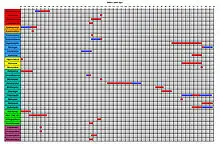Temporal paradox (paleontology)
The temporal paradox, or time problem is a controversial issue in the evolutionary relationships of birds. It was described by paleornithologist Alan Feduccia in 1994.[1][2] It reflects a conflict between where chronologically fossils are expected to be found based on a proposed phylogeny, and where they are actually found. The temporal paradox can give rise to alternative phylogenies (i.e. the archosaurian hypothesis of bird evolution). Statistical measures have been devised to assess the likelihood of proposed phylogenies based on the size and positioning of gaps in the fossil record.
Objection to consensus

The concept of a "temporal paradox" is based on the following facts. The consensus view is that birds evolved from dinosaurs, but the most bird-like dinosaurs, including almost all of the feathered dinosaurs and those believed to be most closely related to birds are known mostly from the Cretaceous, by which time birds had already evolved and diversified. If bird-like dinosaurs are the ancestors of birds they should, then, be older than birds, but Archaeopteryx is 155 million years old, while the very bird-like Deinonychus is 35 million years younger. This idea is sometimes summarized as "you can't be your own grandmother". As paleontologist Peter Dodson pointed out:
I hasten to add that none of the known small theropods, including Deinonychus, Dromaeosaurus, Velociraptor, Unenlagia, nor Sinosauropteryx, Protarchaeopteryx, nor Caudipteryx is itself relevant to the origin of birds; these are all Cretaceous fossils ... and as such can at best represent only structural stages through which an avian ancestor may be hypothezised to have passed.[3]
Fitting phylogenies to the fossil record
How well a proposed phylogeny fits the fossil record is indicative of the likelihood that the phylogeny is a true representation of evolutionary relationships. Interrecord gaps in the fossil record (ghost lineages) are a key indicator: the longer a ghost lineage chronologically, the less likely that the first appearance of the terminal organism (FAD) is evolved from the predecessor. Various composite measures of ghost lineages in a proposed phylogeny have been formulated: MSM*, SCI, GER, SMIG.
Problems
Numerous researchers have discredited the idea of the temporal paradox. Paleontologist Lawrence Witmer (2002) summarized this critical literature by pointing out that there are at least three lines of evidence that contradict it.[4]
First, no one has proposed that maniraptoran dinosaurs of the Cretaceous are the ancestors of birds. They have merely found that dinosaurs like dromaeosaurs, troodontids and oviraptorosaurs are close relatives of birds. The true ancestors are thought to be older than Archaeopteryx, perhaps Early Jurassic or even older. The scarcity of maniraptoran fossils from then is unsurprising as fossilization is a rare event requiring special circumstances, and fossils of animals in sediments from ages that they actually inhabited may never be found.
Second, fragmentary remains of maniraptoran dinosaurs actually had been known from Jurassic deposits in China, North America, and Europe for many years. For example, the femur of a tiny maniraptoran from the Late Jurassic of Colorado was reported by Padian and Jensen in 1989 [5] while teeth of dromaeosaurids and troodontids are known from Jurassic England.[4] Complete skeletons of Middle-Late Jurassic maniraptorans were subsequently described from China. The known diversity of pre-Tithonian (and thus pre-Archaeopteryx) non-avian maniraptorans includes Ornitholestes, the possible therizinosaur Eshanosaurus, the troodontids Anchiornis[6] and Hesperornithoides, the scansoriopterygids Epidexipteryx and Epidendrosaurus [7] and the basal alvarezsaur Haplocheirus.
Third, if the temporal paradox would indicate that birds should not have evolved from maniraptoran theropod dinosaurs, then this raises the question of what animals would be more likely ancestors considering their age. Brochu and Norell (2001) analyzed this question using six of the other archosaurs that have been proposed as bird ancestors, and found that all of them create temporal paradoxes – long stretches between the ancestor and Archaeopteryx where there are no intermediate fossils – that are actually worse. The MSM value for the theropod option was 0.438–0.466.[8] Pol and Norell (2006) calculated MSM* values for the same proposed bird ancestors and obtained the same relative results. The MSM* value for the theropod option was 0.31–0.40.[9] Thus, even if one used the logic of the temporal paradox, one should still prefer dinosaurs as the ancestors to birds.[10]
See also
References
- Feduccia, Alan (1994). "The Great Dinosaur Debate". Living Bird. 13: 29–33.
- Feduccia, Alan (1996) "The Origin and Evolution of Birds." Yale University Press. New Haven, Conn. USA.
- Dodson, P. (2000). "Origin of Birds: The Final Solution?". Integrative and Comparative Biology. 40 (4): 504–512. doi:10.1093/icb/40.4.504.
- Witmer, L.M. (2002). “The Debate on Avian Ancestry; Phylogeny, Function and Fossils”, “Mesozoic Birds: Above the Heads of Dinosaurs” pp. 3–30. ISBN 0-520-20094-2
- Jensen, James A. & Padian, Kevin (1989). ""Small pterosaurs and dinosaurs from the Uncompahgre fauna (Brushy Basin member, Morrison Formation: ?Tithonian), Late Jurassic, western Colorado". Journal of Paleontology. 63 (3): 364–373. doi:10.1017/S0022336000019533.CS1 maint: uses authors parameter (link)
- Hu, D.; Hou, L.; Zhang, L.; Xu, X. (2009). "A pre-Archaeopteryx troodontid theropod from China with long feathers on the metatarsus". Nature. 461 (7264): 640–3. Bibcode:2009Natur.461..640H. doi:10.1038/nature08322. PMID 19794491.
- Zhang, F.; Zhou, Z.; Xu, X.; Wang, X.; Sullivan, C. (2008). "A bizarre Jurassic maniraptoran from China with elongate ribbon-like feathers". Nature. 455 (7216): 1105–8. Bibcode:2008Natur.455.1105Z. doi:10.1038/nature07447. PMID 18948955.
- Brochu, Christopher A.; Norell, Mark A. (2000). "Temporal congruence and the origin of birds". Journal of Vertebrate Paleontology. 20 (1): 197–200. doi:10.1671/0272-4634(2000)020[0197:TCATOO]2.0.CO;2.
- Pol, Diego; Norell, Mark (2006). "Uncertainty in the Age of Fossils and the Stratigraphic Fit to Phylogenies". Systematic Biology. 55 (3): 512–521. doi:10.1080/10635150600755446. PMID 16861213.
- Brochu, Christopher A. Norell, Mark A. (2001) "Time and trees: A quantitative assessment of temporal congruence in the bird origins debate" pp. 511–35 in "New Perspectives on the Origin and Early Evolution of Birds" Gauthier&Gall, ed. Yale Peabody Museum. New Haven, Conn., USA.